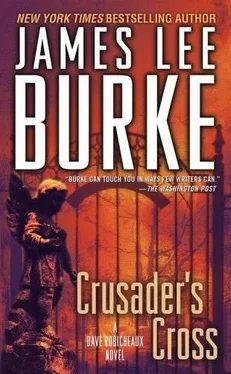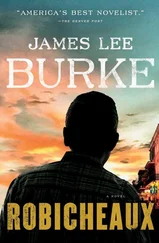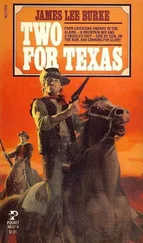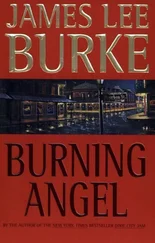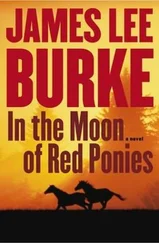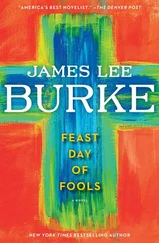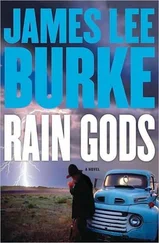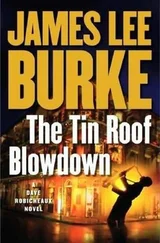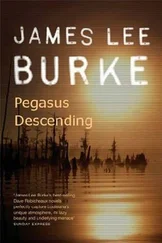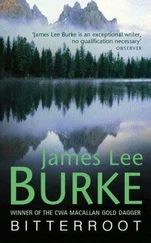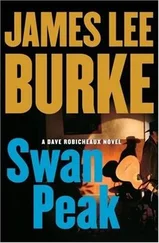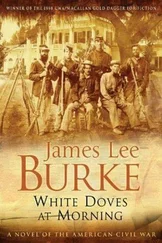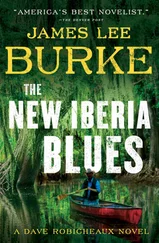During the next five hours Clete and I covered the Quarter, the lower end of Magazine, a strip of water-bed motels on Airline, and a half dozen bars across the river in Algiers. New Orleans' tradition of vice and outlawry goes back almost two hundred years, when the French used southern Louisiana as a dumping ground for both criminals and prostitutes. It doesn't take much imagination to guess at the kind of offspring they bred.
The pirates Jean and Pierre Lafitte and their business partner James Bowie made large sums smuggling slaves from the West Indies through the bayous, in violation of the federal prohibition of 1807, which forbade the importation of slaves into the United States. Brothels and gambling halls thrived, shootings and knifings were commonplace, and stolen goods from the Spanish Main could be found in the best homes along St. John's Bayou. The woman considered the wisest person in old New Orleans was a witch by the name of Marie LeVeau. Outside of Mardi Gras, the most well-attended and festive celebrations in the city were the public hangings, conducted in front of St. Louis Cathedral.
Those hedonistic and pagan traditions are still alive and well in contemporary New Orleans, modernity's influence upon them cosmetic if non-extant. Crack cocaine hit the city like a hydrogen bomb in the 1980s, decimating black communities and the political viability they had gained during the Civil Rights era. Alcoholism is not a disease here but a venerated family heirloom. The Mafia introduced itself in New Orleans in 1890 by murdering the police commissioner and has been here ever since. Upscale brothels with baroque interiors and carriage houses may have become interesting anachronisms, but the industry of prostitution itself is more widespread, uncontrolled, disease-ridden, and dangerous than it has ever been.
Pimps don't have to seek recruits. Crack addicts, runaways, and desperate single mothers are everywhere, many of them glad to have the protection of a pimp who does not physically abuse them. Clete and I talked to a sixteen-year-old girl from Iowa, street name Holly, who had tracks on her arms, doll-like circles of orange rouge on her cheeks, and a black eye a John gave her after he tried to force her to perform oral sex on him without paying. The pimp, who posted bail for his girls regularly through Nig Rosewater and Wee Willie Bimstine, found the John and used a tire iron to extort three hundred dollars from him, half of which he gave to the girl.
"So you think Claude isn't a bad dude?" I said to her.
She was sipping a Coke through a straw at an outdoor table at McDonald's. Her pimp, whose name was Claude Deshotels, had instructed her to tell us whatever we wanted to know. "He's got his moments," she said, looking at the intersection, where two black women in skin-tight white shorts were talking to a man through a car window.
"You know a guy by the name of Bob Cobb? Some people call him Bad Texas Bob," I said.
"What's he look like?" she asked.
"Old, dresses like a cowboy, long teeth, used to be a cop," Clete said.
She twisted her lips thoughtfully. She was overweight, powdered, her hair dyed gold, hanging in tresses on her shoulders. She looked like a girl who could have worked at a small-town dollar store or the McDonald's where we were eating. "Got lines around his mouth like a prune?" she said.
"Sounds like our guy," I said.
"There was an old guy who told me to call him Bob. He put a gun and a blackjack on the nightstand. He kept a cigarette burning in the ashtray while we did it," she said.
"How long ago?" I said.
"Two, maybe three weeks," she said.
"Did he say anything about wanting to clip somebody? Anything about a kite being up on somebody?" I asked.
"Kill them?" she said.
"Yep," I said.
"I don't get in the car with Johns like that."
"How do you know when not to get in a car?" Clete said.
"I can just tell, that's all. That's why nothing real bad ever happened to me. The dangerous ones look at you in a certain way. You can always tell."
"The old guy named Bad Texas Bob is dead. He can't hurt you. You sure you don't remember anything else about him?" I said.
"Cops don't talk when they do it. They just want to get off, then pretend they don't know you. Can I have another Big Mac?" she said.
But in our search through New Orleans we had little success in finding the individual who was of most interest to us – Apollonaire Babineau, also known as Jigger Babineau because he had served his apprenticeship in the Mob as a lookout man for a gang of smash-and-grab jewel thieves.
Jigger was actually a coonass from Barataria, who had never shed his accent or his Cajun attachment to both his wife and mother. But perhaps because of his christened name, Jigger suffered delusions of grandeur. He claimed he had helped Jack Murphy rob the richest women in Miami and West Palm Beach of their jewels, and on a dare had picked the coat pocket of Meyer Lansky at Joe's Stone Crab. As miscreants go, he was a fairly innocuous character, an anachronism from an earlier era who believed washing stolen and counterfeit money at racetracks was honorable work suitable for a family man.
Unfortunately for Jigger, he was a degenerate gambler and he lost a pile of money from an armored car robbery in a card game run by the Giacano family. The game got busted, two of the Giacanos went away for the armored car job, even though they were innocent, and Jigger had to go into Witness Protection. Clete and I were the cops who busted the game.
We tried Jigger's cottage off Tchoupitoulas and hunted in the bars where he drank. He had left Witness Protection after Didoni Giacano died of colon cancer, but obviously he had learned we were looking for him and had decided to fly under the radar. We began to believe Jigger had blown the Big Sleazy.
That Saturday night we stayed in Clete's apartment above his office on St. Ann Street, and in the morning went to Jigger's cottage again and to a pool hall where he sometimes shot nine ball. No Jigger. We ended up at a lunch counter in the Carrollton district, empty-handed, discouraged, looking through the window at the St. Charles streetcar warping in the heat. Clete glanced at his watch. "It's twelve-thirty Sunday," he said.
"So what?" I said.
"I wasn't thinking. Order some meatball sandwiches to go and meet me on the back end of Audubon Park," he said.
He was out the door and down the street in his Caddy before I could reply.
A half hour later I was laying out our lunch on a picnic table under a live oak dripping with Spanish moss when I saw the Caddy coming hard up the street, swerving in a shower of leaves at the park's entrance. Clete parked in a shady spot among the trees and walked across the grass toward me, a small ice cooler swinging from his hand, an unlit cigarette bouncing in his mouth. "You get some pecan pie?" he said.
"Where'd you go?" I said.
"The old Washington Street Cemetery." He ripped the tab off a beer and drank from it. His face was hot and flushed in the heat, the can cold-looking and beaded with moisture in his big hand.
"So why'd you go to the cemetery?" I said.
"Let's eat first. Wow, what a scorcher. You could fry eggs on the sidewalk."
I began to regret we'd come to New Orleans. We'd revisited the underside of the city, a world of avarice, use, and deceit, even enlisting the aid of a pimp in order to interview a child prostitute, gaining nothing of value in turn except the cynical knowledge that no vice flourishes without sanction. I wanted to take a shower and burn my clothes. I wanted to be back in New Iberia with Molly Boyle.
Clete finished eating and pinched a paper napkin on his mouth, then studied his convertible, his jaw cocked thoughtfully. Some black teenagers had been parked by Clete's vehicle for a few minutes, their radio blaring, but they had driven away and now the Caddy sat by itself in the warm shade of the oak tree. Clete stuffed our trash in a barrel and hefted up his ice cooler. "Let's rock," he said.
Читать дальше
